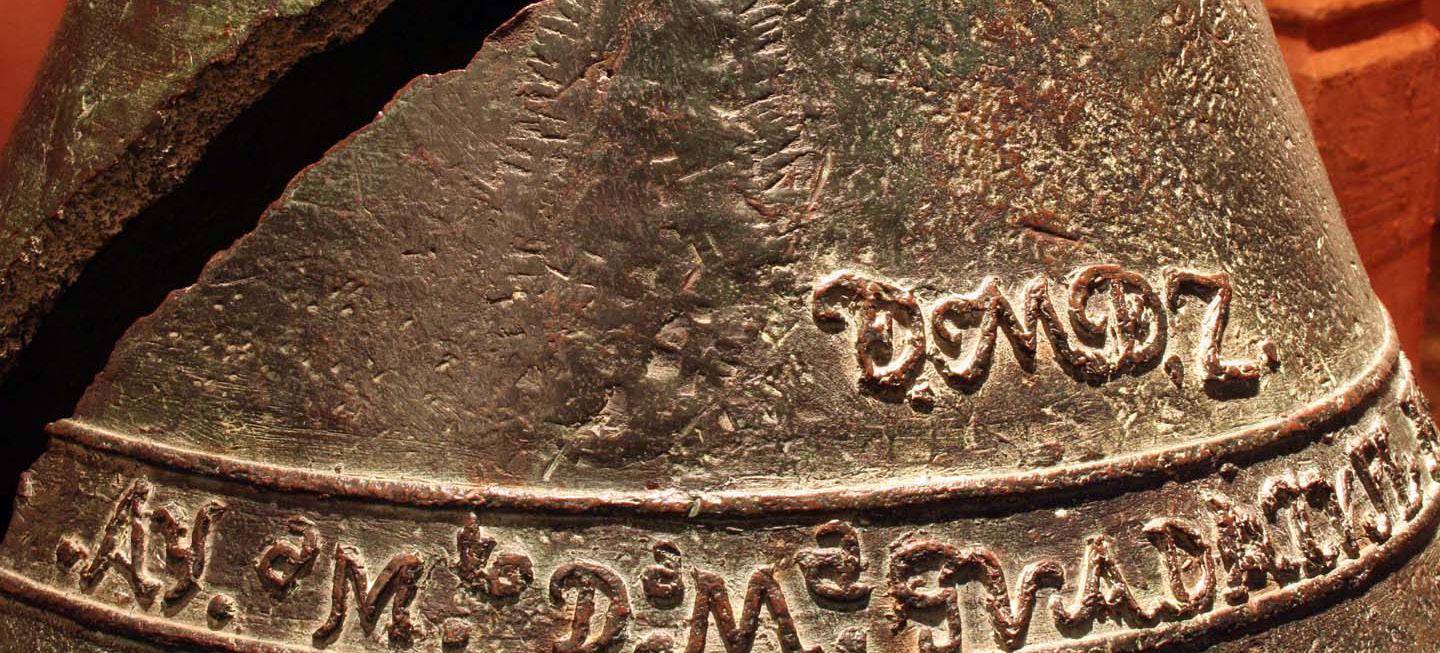
5 minute read
Most History: The Bell, Part 2

The sound of bells – from the light “dinging” of hand bells to the deep boom of churchtower bells – has long been an integral part of life along our lower Rio Grande.
Whether calling the faithful to services, sounding an alarm, or heralding the coming and going of river steamer or locomotive, bells have marked the cycles of the year and events great and small for those along the Great River.
In the second-floor section known as the “River Highway” (part of the Museum’s signature exhibit series, Rio Grande Legacy) is a large bronze bell, cracked down one side. Over thirty years ago this weathered relic came to light in a scrap yard at San Juan, Texas, under a load of junk metal from Monterrey, Nuevo León. Upon finding the bell, the yard manager made a phone call, and presently word of it came to the then Hidalgo County Historical Museum in Edinburg. Intriguing enough as an artifact, the bell stirred even more interest because of the raised lettering in old Spanish around it, and a date: March 6, 1836 – the day the Alamo fell.
There was much excitement locally, and much speculation – namely, did the bell have anything to do with the battle of the Alamo? The question was bound to come up, not only because of the famous date but also because of the year itself. For, by coincidence (or maybe not; the universe works in strange ways at times) the bell’s arrival and discovery occurred early in 1986, the year of the Texas Sesquicentennial -- the 150th anniversary of the Texas Revolution itself.
For some time after its discovery the bell was displayed in San Juan, and that city wanted to keep the bell. But the scrap yard was owned by an HCHM trustee, and eventually the “Alamo Bell” (as it was inevitably christened) was donated to the HCHM (now the MOSTH) where it has been on exhibit ever since.
A study of the veteran relic hints at its past. A gaping crack spirals up from the bottom rim (in bell lingo, the “sound bow”); there a clapper struck repeatedly over many years, suggesting that the bell did not swing but hung stationary. There is further wear in the “cannons”, cast-on loops on top used for suspending the bell. Two of them are deeply worn, possibly from iron chains; similar old campanas still hang that way, in church towers across the Rio Grande. Although stationary, the bell probably swayed a bit when being struck; the chains probably wearing slowly into the loops. Another mystery is on the front: faintly visible in low relief is an oval-shape halo of light rays where, at one time, an image of the Virgin of Guadalupe must have been present. What happened to it, and why was it removed?
NO ONE KNOWS.
And what about an “Alamo connection”? The answer may lie in the Spanish inscription encircling the bell. The lettering is mostly a mixture of words, abbreviations, and symbols in an older form of Spanish; the famous date was recognized quickly, but a more complete transcription came later. Here is what appears around the bell (unfortunately the computer doesn’t include antique Spanish abbreviations in its program, so some of the contractions are given as words):
De . M De . Z …PE . ECHA ESPENSAS . De . ESTE RESYNDARYO . P . DYSPOS.on De S . Y[?] [break in the bell] . AY. a Mto. Da . Ma . GVADALVPE . ECHA … Po Bo Mzo 6 De 1836
Shortly after the bell came to HCHM, Edinburg attorney and historian Laurier B. McDonald, a Museum Founder with a lifelong interest in this region’s past, offered to help untangle the inscription. Using an obscure but essential book, The Handbook for Translators of Spanish Historical Documents (published in 1941 by the University of Texas), he suggested the following transcription and translation:
ECHA A (LA) ESPENSA DE ESTE RESYNDARIO POR (LA) DISPOSICION DE S [break] ALLELUJA MUERTE DONA MARIA GUADALUPE DE MELENDEZ
PEDRO BEATO MARZO 6 1836 Translation:
MADE AS AN OFFERING OF THIS COMMUNITY THROUGH THE GOOD GRACES OF S/ [break] IN MEMORY OF THE LATE DONA MARIA GUADALUPE DE MELENDEZ
BLESSED PETER MARCH 6, 1836
Meanwhile, a copy of the inscription had been sent to the University of Texas at Austin, asking if they could help. UT-A suggested the following translation:

MADE AT THE EXPENSE OF THIS NEIGHBORHOOD FOR [or BY?] THE DISPOSITION OF S. A. Ya. D. Ma. GUADALUPE
According to UT, the six-letter formula might stand for:
S(anta) Y(lustrisima?) (de la?) M(adre) D(ona) M(aria) (de) GUADALUPE
That is where the matter lies. A connection with the Alamo has not been established. Based on what we do know, this is probably the general story: Sometime around 1836 the congregation of an unidentified location in Mexico (perhaps in or near Monterrey, N.L.?), had a church bell cast. The bell’s inscription may commemorate the underwriting of the bell by a local person; or it may, in some manner, commemorate Santa Anna’s victory at the Alamo. During its service life the bell evidently hung stationary, and was rung by a clapper striking the rim at the same place; this probably caused the bell to crack eventually.
Later the bell was removed from the tower (did it fall, causing the crack to widen and spiral?) The raised-relief image of the Virgin of Guadalupe was erased, leaving only the faint outline of the halo. Later still the bell was sold for scrap, and ended up in San Juan, Texas in 1986. The rest, as they say, is history. Efforts to obtain a final translation of the inscription will continue, possibly putting to rest the mystery of the bell.

Important conversations are happening right now
Be part of them

SOCIALIFE with Martha Benavides
NEW EPISODES: Thursdays at 5:30PM See the episodes on YouTube

SOCIALIFE RGV








